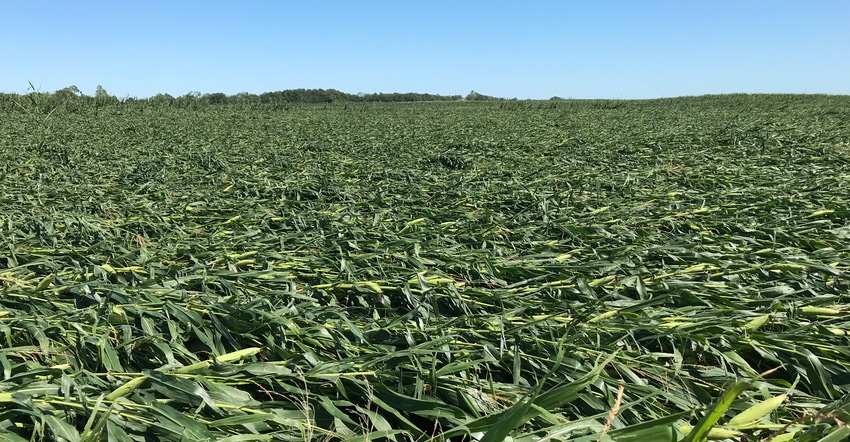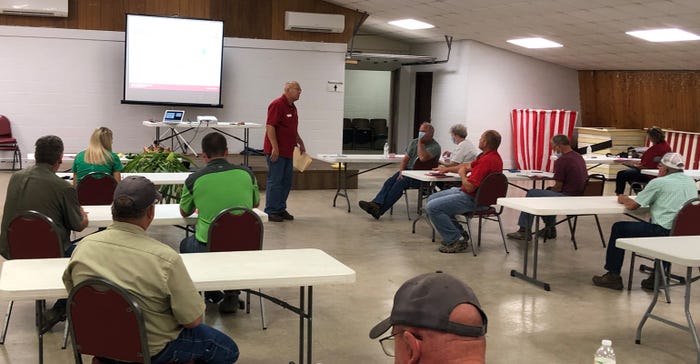August 13, 2020

While some rainfall has come to the droughty areas of the state this past week, the drought rating is still D3 (extreme) in parts of central and west-central Iowa, according to USDA’s drought map. Rain is welcome but not as part of a hurricane-like windstorm. But that was the case Aug. 10 when derecho winds plowed through about a third of the state, damaging buildings and crops.
A derecho is a line of intense, widespread and fast-moving thunderstorms with damaging winds that travel across a great distance. “Our thoughts are with all Iowans as they work to assess and recover from damage. This is some of the heaviest crop damage we’ve seen in many, many years,” notes Meaghan Anderson, Iowa State University Extension field agronomist in central Iowa.
What’s happening in your fields?
Other crop-related issues noted by ISU Extension field agronomists in Iowa this past week before the Aug. 10 storm include fast-maturing crops, two-spotted spider mites, spotty foliar diseases, a general tapering off of some insect pests, and continued concerns about off-target dicamba herbicide movement. Here are reports on what’s happening in different regions across the state.
Northwest
Joel DeJong, Region 1. “In the northwest corner of Iowa, we received nice rainfall in the past week in about the southern half of the area I serve. The north half of my area had only a few tenths of an inch. We missed most of the severe wind damage and offer our sympathy to the people in the hard-hit areas of Iowa.
“Lack of soil moisture remains an issue in much of our northwest Iowa area. Tip-back of kernels on corn ears is very prominent. That is, ears with no kernels on the area near the tip of the ear. Also, the maturity of plants in the driest areas is speeding along quicker than we like to see. Spider mites are common, but soybean aphid numbers, although present in more fields, seem to be staying below thresholds in most fields. The waterhemp misses are becoming more visible in soybean fields, too."
Northwest
Paul Kassel, Region 2. “Corn and soybean crops continue to deal with dry soil conditions across much of the area where I am located. Parts of Sac County are now classified as D3 extreme drought. And parts of Buena Vista, Pocahontas, Clay and Palo Alto counties are dealing with D2 severe drought. Some rainfall amounts of 0.5 to 1 inch have occurred in parts of Kossuth, Hancock and Winnebago counties recently. Crop development also appears to be progressing rapidly as corn approaches the dent stage.

DROUGHT MEETING: Farm programs, crop insurance and crop management were discussed at drought meetings during the first week of August.

“We have soybean fields that are approaching the full bean [or] R6 stage of development. The amount of time from R6 stage until R7 [or] early maturity stage is around 20 days. Insect pest problems have been low so far in my area of northwest Iowa. Farmers and applicators are encouraged to check soybean fields for soybean aphid development. Soybean aphid populations have been light, so far. The risk of damage from soybean aphid is reduced once the soybean crop reaches the R6 stage."
North-central
Angie Rieck-Hinz, Region 3. “Rains continue to be spotty, but nearly every reporting station across my nine counties reported some rain during the week of Aug. 3 through Aug. 10. Rainfall ranged from 0.18 inch at Rockwell City to 1.13 inches at Fort Dodge. Eldora and Hampton continue to see only about 20% to 25% of their average rainfall for this time of year. Rainfall reports for the storm that pushed through on Aug. 10 are so varied that I don’t think it will do much to alleviate our drought concerns in the more severely impacted areas.

DROUGHTY SOYBEANS: In central Iowa, drought symptoms on soybeans is showing up on this sandy loam soil in Story County.

“There continues to be little corn disease pressure in the majority of fields. On soybeans, I’ve seen some frogeye leaf spot, but at low levels. I was in Rockwell City when the Aug. 10 storm hit. A crop tour after the storm with a local farmer and seed dealer showed there were corn plants leaning over and tattered soybean plants in scattered places. I tracked this on my way home with scattered crop damage in southern Webster and Hamilton counties. I live in northern Story County and once you get east of the Interstate 35, there are numerous acres of flattened corn, tattered and lodged beans, and missing grain bins, plus a lot of structural damage."
Northeast
Terry Basol, Region 4. “Like most of the state, corn and soybeans in northeast Iowa could use some precipitation. All the northeast counties have entered the category of D0 (abnormally dry), according to the U.S. Drought Monitor. Most of the corn is finishing up the R3 stage (milk stage of growth) and has begun the R4 stage (dough stage). According to USDA National Agricultural Statistics Service, 77% and 59% of the corn as of Aug. 9 in north-central and northeast Iowa, respectively, is in dough stage of growth.
“The most common foliar disease that’s shown up in the last few weeks is gray leaf spot. Some isolated cases of tar spot have been reported and confirmed in Floyd, Butler, Black Hawk and Buchanan counties, but tar spot infestations have generally few and far between. Soybeans are finishing up the R4 growth stage and beginning early stage R5. Japanese beetle feeding is now tapering off in most soybean fields, but you should continue to monitor defoliation levels, as grasshoppers are also feeding. In dry years, grasshoppers can become problematic as their normal vegetative food sources are decreased and they turn to feeding on soybeans.
For more information on scouting and thresholds for pests that feed on soybeans, read the ICM article Scouting guidelines for soybean defoliators . We could use a good drink from Mother Nature, as we have only received 1.07 inches of rain at the Northeast Iowa Research and Demonstration Farm since Aug. 1, according to the Iowa Mesonet."
Central
Meaghan Anderson, Region7. “Most of central Iowa received anywhere from a ½ inch to more than 3 inches of rain last week. This rain was needed, but droughty areas are still at half of normal rainfall for the last 60 days, so most areas got a small drink compared to what is needed. Unfortunately, the most recent rainfall brought significant wind that impacted cornfields over nearly the entire region that I serve.”
“Cornfields that were in R4 (dough) to early dent (R5) stage of growth are now facing finishing out kernel fill with plants mostly on the ground. Harvest will be especially arduous this fall. Bob Nielsen (Purdue University) wrote an article in 2018 outlining the effects of severe stresses during corn grain fill that is very useful. Prospects for recovery in these fields do not seem encouraging this late in the growing season. Additionally, the storm caused significant structural damage to livestock buildings, farm sheds, homes and grain bins.
“Weedy areas of soybean fields continue to become more apparent, and I've received phone calls recently with questions about weeds surviving 2,4-D and dicamba herbicide applications. Resistance to these herbicides has been discovered in Palmer amaranth in other states but has not yet been officially reported in Iowa waterhemp populations.
Speaking of Palmer amaranth, now is a great time to be scouting for it in Iowa. In my area of Iowa, insect issues in both corn and soybeans are mostly tapering off. Phone calls this week are about corn recovery from wind damage, weed identification, two-spotted spider mites in soybeans and Japanese beetles in corn and soybeans."
East central, southeast, south central
Virgil Schmitt, Region 9. “Rainfall last week in the counties I cover was generally less than one-tenth of an inch. In general, temperatures last week in east-central, southeast and statewide were cooler than normal. Most cornfields are at R4 growth stage and are generally looking good, except for storm-damaged fields. Gray leaf spot disease lesions on corn, and occasional sightings of tar spot disease continue. Soybeans are mostly in R5 growth stage. Beans also look good, except storm-damaged fields. Dicamba herbicide drift, potential weed resistance to dicamba and late-summer seeding of cover crops were common topics of discussion last week."
Get questions answered: You can find your local ISU Extension field agronomist and their contact information here.
About the Author(s)
You May Also Like






